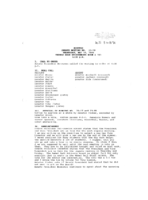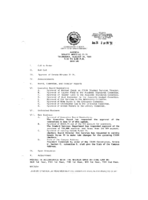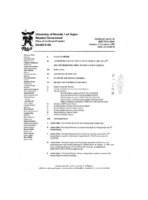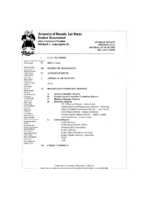Search the Special Collections and Archives Portal
Search Results

Meeting minutes for Consolidated Student Senate University of Nevada, Las Vegas, May 19, 1993
Date
1993-05-19
Archival Collection
Description
Includes meeting agenda and minutes, along with a National Student Exchange booklet. CSUN Session 23 Meeting Minutes and Agendas.
Text

Meeting minutes for Consolidated Student Senate University of Nevada, Las Vegas, January 13, 1997
Date
1997-01-13
Archival Collection
Description
Includes meeting agenda and minutes.
Text

Meeting minutes for Consolidated Student Senate University of Nevada, Las Vegas, August 29, 1991
Date
1991-08-29
Archival Collection
Description
Includes meeting agenda and minutes.
Text

Interview with Katie McWilliam, July 9, 2004
Date
2004-07-09
Archival Collection
Description
Narrator affiliation: Consultant for Seismological Issues
Access note: Audio temporarily sealed
Access note: Audio temporarily sealed
Text

Interview with Charles E. Violet, May 22, 2004
Date
2004-05-22
Archival Collection
Description
Narrator affiliation: Physicist, Lawrence Livermore National Laboratory
Text

Interview with Richard Lawrence Garwin, July 21, 2004
Date
2004-07-21
Archival Collection
Description
Narrator affiliation: Physicist, IBM; Consultant, Los Alamos National Laboratory
Text

Interview with James Nobuo Yamazaki, October 14, 2005
Date
2005-10-14
Archival Collection
Description
Narrator affiliation: Physician in Charge, Atomic Bomb Casualty Commission, Nagasaki
Text

Meeting minutes for Consolidated Student Senate University of Nevada, Las Vegas, January 28, 2002
Date
2002-01-28
Archival Collection
Description
Includes meeting agenda and minutes.
Text

Meeting minutes for Consolidated Student Senate, University of Nevada, Las Vegas, November 08, 1999
Date
1999-11-08
Archival Collection
Description
Includes meeting minutes along with additional information about State of the Senate Address.
Text

Meeting minutes for Consolidated Student Senate, University of Nevada, Las Vegas, June 30, 2003
Date
2003-06-30
Archival Collection
Description
Includes meeting agenda and mintues, along with additional information about memorandums, bylaws, and the Articles of Incorporation for the Rebel Yell Student Newspaper.
Text
Pagination
Refine my results
Content Type
Creator or Contributor
Subject
Archival Collection
Digital Project
Resource Type
Year
Material Type
Place
Language
Records Classification
